
SKIING HISTORY
Editor Kathleen James
Art Director Edna Baker
Contributing Editor Greg Ditrinco
ISHA Website Editor Seth Masia
Editorial Board
Seth Masia, Chairman
John Allen, Andy Bigford, John Caldwell, Jeremy Davis, Kirby Gilbert, Paul Hooge, Jeff Leich, Bob Soden, Ingrid Wicken
Founding Editors
Morten Lund, Glenn Parkinson
To preserve skiing history and to increase awareness of the sport’s heritage
ISHA Founder
Mason Beekley, 1927–2001
ISHA Board of Directors
John Fry (1930-2020), Chairman
Seth Masia, President
Wini Jones, Vice President
Jeff Blumenfeld, Vice President
John McMurtry, Vice President
Chan Morgan, Treasurer
Einar Sunde, Secretary
Richard Allen, Skip Beitzel, Michael Calderone, Christin Cooper, Art Currier, Dick Cutler, Chris Diamond, David Ingemie, Rick Moulton, Wilbur Rice, Charles Sanders, Bob Soden (Canada)
Presidential Circle
Christin Cooper, Billy Kidd, Jean-Claude Killy, Bode Miller, Doug Pfeiffer, Penny Pitou, Nancy Greene Raine
Business & Events Manager
Kathe Dillmann
P.O. Box 1064
Manchester Center VT 05255
(802) 362-1667
kathe@skiinghistory.org
Membership Services
Laurie Glover
(802) 375-1105
laurie@skiinghistory.org
Corporate Sponsorships
Peter Kirkpatrick
(541) 944-3095
peterk10950@gmail.com
Bimonthly journal and official publication of the International Skiing History Association (ISHA)
Partners: U.S. Ski and Snowboard Hall of Fame | Canadian Ski Museum and Hall of Fame
Alf Engen Ski Museum | North American Snowsports Journalists Association | Swiss Academic Ski Club
Skiing History (USPS No. 16-201, ISSN: 23293659) is published bimonthly by the International Skiing History Association, P.O. Box 1064, Manchester Center, VT 05255.
Periodicals postage paid at Manchester Center, VT and at additional mailing offices. Postmaster: Send address changes to ISHA, P.O. Box 1064, Manchester Center, VT 05255
ISHA is a 501(c)(3) public charity. EIN: 06-1347398
Written permission from the editor is required to reproduce, in any manner, the contents of Skiing History, either in full or in part.
Short Turns (Sept-Oct 2020)
The Lighter Side of Ski Movies
Hall of Famer Sverre Engen influenced many aspects of the sport. Perhaps none as enduring as lightening the load for ski movie production.
By Mike Korologos
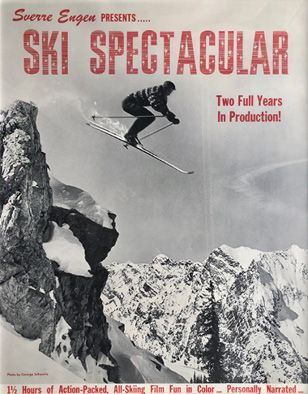
In the late 1940s and early 1950s, when ski movie-making was in its infancy, major outdoor filmmakers used “Hollywood methods” of production. Ski-movie shoots were built on the foundation of cumbersome 35-mm cameras affixed atop bulky tripods, with these setups hand-carried from ski lifts to scenic locations by camera crews that did not ski. Often these daylong efforts resulted in 10 to 15 seconds of usable footage.
Pioneering filmmaker Sverre Engen helped turned that laborious process on its head, forever changing how action sports films were made, according to his son, Scott Engen. “Dad may not have been the first to make ski movies, but he sure helped revolutionize the way they were produced,” Scott says.
Sverre honed his film-making skills in the early 1930s and early 1940s while hiking, hunting and working for the Utah Fish and Game Department as he produced and shot informational and educational movies as part of his job.
He also produced, while assigned to the 10th Mountain Division at Camp Hale, Colorado, morale-boosting broadcasts for the Free Norwegian expatriate members in the U.S. and Canada. “In those jobs, Dad came to fully appreciate the virtues of moving fast and traveling light when it came to carrying equipment in the mountains in the winter,” Scott says.
Unlike most ski-movie filmmakers at the time, Sverre was an accomplished skier, which greatly helped him with his movie projects. Traveling light and being nimble with his on-snow production methods provided cost- and time-saving efficiencies, which allowed him to travel into the wilderness to film spectacular scenic footage. Those scenic shots became the signature look of the dozen or so 90-minute ski movies he would later produce.
Born in Norway in 1911, Sverre learned to ski at 2 and moved to the United States at 18, soon settling in Utah. He was among the last of a colorful generation of Norwegian immigrants who were deeply involved in many aspects of the sport. Sverre gained fame as a jumping champion, resort operator, ski instructor, pioneer in the study of avalanche control and maker of ski movies. He served as Alta’s ski school director and as the cofounder and first manager of the new Rustler Lodge at Alta. The U.S. Forest Service named him as Alta’s first snow ranger in 1947 and he coached the University of Utah Ski Team to its first national collegiate championship that same year. He also found time to help build ski jumps at Ecker Hill, Becker Hill and Landes Hill, all in Utah.
Engen was inspired to make his own movies while appearing in several of Fox Movietone’s Ski Aces vignettes. These short films, shown on movie screens across the country as lead-ins to the day’s feature film, starred Sverre and his brothers Alf and Corey skiing down gorgeous powdery mountainsides or in zany ski scenes.
Sverre’s penchant for traveling light found him embracing the latest equipment that came on the civilian market at the end of World War II. This included the classic Bell and Howell 70-D series 16 mm camera. Sverre would have seen this camera used by John Jay when filming for the 10th Mountain Division. Driven by a hand-wound, clockwork spring motor, it didn’t require batteries, which annoyingly would fail in the wet or cold of the mountains or merely peter out during a shoot.
The camera’s downside, explains Scott, was the time and total darkness required to change rolls of film in the mountains. It had to be done only by feel and often by cold and numb fingers. He said his dad stashed a heavy, black canvas lightproof film-changing bag with arm sleeves in his rucksack. In a pinch, he would use his ski parka, folding over the neck and waist hems to improvise a film-changing bag, using the sleeves for access.
“Never wanting to miss a great action scene, Dad sometimes carried three fully loaded D-70 cameras,” Scott said. “Later he used a compact Bell and Howell 16 mm camera that used 50-foot long film magazines that could be instantly installed in the camera. The magazines were about the size of a small paperback book and designed for the gun cameras used in WWII fighter planes.” Sverre now had his “ideal film-making package,” Scott said. “He could ski anywhere with several small, lightweight, spring-driven cameras, each featuring instant magazine loading.”
He also was a natural promoter, helping to build brand awareness decades before that was a concept. The three Engen brothers barnstormed the country in the 1930s and 1940s, staging ski-jumping shows before tens of thousands of spectators. He touted that fame in his promotional posters and media interviews. And Sverre also had an influential friend: Lowell Thomas, the famous radio commentator, who skied with him several times a year at Alta.
In his book, Skiing a Way of Life, Saga of the Engen Brothers, Sverre describes golden advice from Thomas. “He suggested I talk more about the action. He said, ‘you know, Sverre, a good commentary is almost as important as the film itself . . . speak louder so people can hear and understand you.’ I worried about my Norwegian accent, but he assured me that it was okay and might add a little flavor.” Often when Sverre appeared on stage for his screenings, especially in New York or Los Angeles, Thomas either would introduce him personally or via recorded messages.
In addition to being a main character in Ski Aces (1944) and Margie of the Wasatch, Sverre’s feature length movies included Champs at Play, Dancing Skis (1956), The Snow Ranger, Skiing, Their Way of Life (1957), Skiing America, Ski Fever (1958), Ski Time USA (1959), Skiing Unlimited and Ski Spectacular (1962). He also produced numerous Fox Movietone episodes and short ski promotional vignettes.
Alta purchased most of Sverre’s original reels in the 1990s, says Alta general manager Michael Maughan. The film rolls have been digitized and stored for posterity.
Mike Korologos’ ski articles have appeared in newspapers and periodicals worldwide for more than 60 years. He was skiing editor for The Salt Lake Tribune for 25 years and a correspondent for SKIING Magazine for 30 years. He served as press chief for the organizing committees for the 2002 Olympic and Paralympic Winter Games in Salt Lake City, his hometown.
photo courtesy Scott Engen
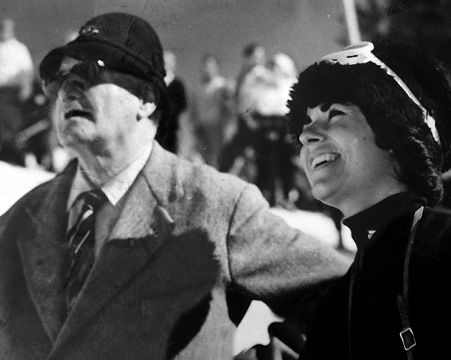 Arnold Lunn and Sandra Heath
Arnold Lunn and Sandra Heath
With the passing of John Fry earlier this year, Sandra Heath was motivated to reach out to Skiing History to convey how John always appreciated, and supported, the telling of a good tale. Heath, who modeled for Bogner in the 1950s and 1960s, writes: “John Fry encouraged me to tell this story. In the winter of 1961, when I was being filmed in the Alps, the Fox-Movietone crew and I had the good fortune of visiting the Bellevue Hotel in Mürren, Switzerland. I was introduced to Sir Arnold Lunn, who asked me to join him watching the dangerous climbing activity on the Eiger. He was enchanting: a poet, philosopher and inspirational genius to the ski world. Some 30 years later, in England, I had a drink at the home of Elisabeth Hussey, with her sister Philippa. Elisabeth was Sir Arnold’s secretary and confidante. She sprang from her chair to retrieve something and said ‘This photo is such a mystery. Do you happen to know who this gal is?’ I was flabbergasted—it was me!”
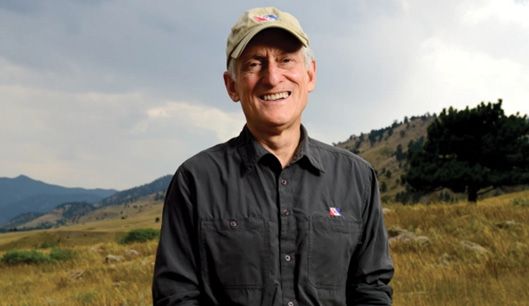
ISHA VP Jeff Blumenfeld Wins Prestigious Exploration Award
Jeff Blumenfeld, ISHA vice president and a self-described “groupie for adventures and explorers,” was recently named the winner of the prestigious 2020 international Leif Erikson Exploration History Award.
Blumenfeld, the editor and publisher of the Boulder, Colorado-based Expedition News website, was recognized for his ongoing work to promote and preserve exploration history. Blumenfeld says that “receiving the award and recognition from the exploration community is quite rewarding. I am privileged to tell their stories.” But what keeps him on task is a bigger mission.
“Exploration is critically important,” he says. “It’s through exploration and field research that we’ll answer many of the questions, many of the mysteries of this planet and hopefully make the world a better place for our children.”
In addition to his work on his website, Blumenfeld is active in helping new explorers gain international exposure, peer recognition and, critically, funding for their research and expeditions.
“If I can foster their efforts, I’m totally rewarded by that,” he says.
The Leif Erikson Exploration awards, which include the History Award and the Young Explorer Award, were established by the Exploration Museum in 2015, and are presented for achievements in exploration and for media coverage and documentation of exploration history.
The museum, located in Húsavík, Iceland, 30 miles from the Arctic Circle, is dedicated to the history of human exploration, from early adventurers through space exploration. Blumenfeld received the award in August in a Zoom ceremony, as part of the annual Húsavík Explorers Festival.
Blumenfeld is an active member of the Explorers Club, and is president of the North American Snowsports Journalists Association. He has written several books to promote travel and exploration, including Get Sponsored: A Funding Guide for Explorers, Adventurers and Would-Be World Travelers and Travel With Purpose: A Field Guide to Voluntourism. 
SKI ART
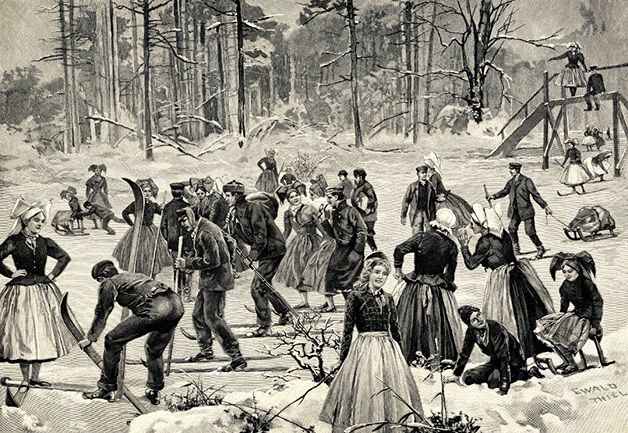
Ewald Thiel (1855-before 1939)
For such a prolific social painter and illustrator, it’s surprising so little is known about German artist Ewald Thiel; we don’t even know when his death occurred. We do know he was born in Kamanten, in East Prussia (now Klimowka in Kaliningrad, Russia) on August 12, 1855. He studied at the Prussian Art Academy in Berlin and in 1878 at the Royal Academy of Art in Munich. He settled in the Halensee region of Berlin.
Thiel became an illustrator of many Berlin scenes, and his work appeared in popular weeklies. He illustrated books and created wood engravings; he drew scenes of lakes and drainage works, the lighting of bridges, exposition openings, and dancers, lawyers, workers, and politicians. Perhaps his most famous sketch (turned into a color portrait) was the drawing of Otto von Bismarck addressing the Reichstag on February 6, 1888 when he proclaimed: “Wir Deutsche fürchten Gott, aber sonst nichts auf der Welt!” (We Germans fear God, but nothing else in the world!).
He drew skiing scenes, too, including a hunter on skis, a skiing postman, and skiers on the Feldberg. He based the scene pictured here on a sketch by Ernst Hosang of the crowd enjoying the Spreewald, Berlin’s nature preserve. In 1866, a railway from the capital reached Lübbenau, a village at the center of the 200-square-mile area of heathland and pine woods crisscrossed by canals.
An enterprising teacher, Paul Fahlisch, had begun promoting tourism here in 1882. The Spreewald soon became the bourgeois’ place to enjoy summer and winter. Many of the skiers in the scene are locals; the women are wearing the traditional headgear of the Sorb community, Slavic immigrants who settled here in the 6th century. Thiel’s careful depiction of the skier with scarf tying down his cap and protecting his ears, one with a pipe, another carrying a sack, and a third putting on a ski, all attest to a well-grounded knowledge of the skiing world of 1899. The picture was published in Das Buch für Alle, a magazine that appealed to the middle class. — E. John B. Allen
Why's it called that?
Sneg, Schnee, Neige: Why do we have different words for snow?
Five or six thousand years ago, near the beginning of the bronze age, a tribe in what is now Ukraine domesticated horses and learned to ride. They quickly spread their culture, and language, in all directions.
No direct record of their language survives, but scholars call it Proto-Indo-European or PIE. By comparing words in Sanskrit, ancient Greek and Latin and modern languages, linguists have come up with a list of about 200 root words from PIE—white was albus, the root of our word Alps.
The PIE word for snow was sneygh. Cultures close to the PIE homeland kept that word: Slavic languages use some variant of sneg, and the tribes north of Central Asia’s Altai mountains, where bronze-age skiing survives to this day, say snig.
In Northern Europe, the word evolved to schnee (German), sneeuw (Dutch), snow (Friesian and English), snø, snö and snjorr (Norwegian, Swedish and Icelandic). In the Mediterranean, proto-Latin (Italic) turned sneygh into snix. Then the s dropped, becoming nix (Classical Latin), neige (French) and nieve or neve (Italian and Spanish). —Seth Masia
SNAPSHOTS IN TIME
1936 RACING ON KENYA’S GLACIERS
British ex-pats held a ski meet on the Lewis glacier on 17,057-foot Mount Kenya, in central Kenya about 90 miles northeast of Nairobi. The sole female contestant—the dashing Nancye Kennaway—won the women’s division and Bill Delap, who started organized skiing on the glacier starting in 1933, won the men’s downhill. The true ski pioneers of the region, however, were German geographer Hans Meyer and Austrian mountaineer Ludwig Purtscheller, who in 1889 became the first people to reach the 16,893-foot summit of Kibo — the highest of Kilimanjaro’s three cones, 200 miles to the south. —E. John B. Allen (Historical Dictionary of Skiing)
1944 CLOSED ON SUNDAYS
For the first several years after its opening in 1944, Timp Haven in Utah’s Provo Canyon was the only ski area in the country that closed on Sundays, due to the religious beliefs of its owner. Paul “Speed” Stewart, a sheep rancher, ran the resort with his brother Ray for more than 20 years. “We just don’t believe in working on Sunday,” Speed’s wife Hilda told the Deseret News in 1965. By that time, his busy resort offered skiing, skating and tubing — but Speed never did learn to ski. “Don’t have the time,” he said. Actor Robert Redford and other investors bought the resort in 1968 and renamed it Sundance. —Mike Korologos
1967 SHOVEL-RIDING GNOMES
While skiing down for our last run, we stopped in the lee of a big cedar tree to look at the view of endless Laurentian hills and frozen lakes stretching out below us. Suddenly, as we all stood there leaning on our ski poles, six little men who looked like tassel-capped gnomes came laughing by us—hell-bent and sliding straight down the mountain—sitting on big, wide snow shovels. Clutching the handle up between their legs, they were having the ride of their lives, speeding with merry abandon over the bumps, down the chutes and through the trees. Their shouts and laughter echoed up the slopes as they went at crazy speeds down the fall line. “Who are those crazy little men?” said Johnny. “Zee trail packers, Monsieur,” said Pierre. We shoved off and chased the “gnomes” to the base of the mountain, swinging through slalom glades, losing them, finding them and laughing all the way. We were in love with the day, the mountain, and the French-Canadian people. —Frankie and Johnny O’Rear,
“Chateau Bon Vivant: The Hilariously True Misadventures of Two Vastly Unequipped Innkeepers Who Run a Ski Lodge in Winter in Old Quebec”
1978 STICK TO THE TRAILS
Don’t go blithely whipping off the trails at Vail, Colorado, this season. Under a new get-tough policy, the U.S. Forest Service is planning to prosecute people who ignore ski-area boundary and trail-closing markers. The penalties: six months in jail and a $500 fine. —SKI (October 1978)
PARKING THE MIND AT KEYSTONE
First the instructor asked us to think of a word that described our skiing. I chose “wobbly.” Mark, a Los Angeles advertising man, chose “strain.” Judy said “tense.” We each acted out our bad quality, exaggerating and clowning. We skied down a gentle intermediate run, clenching our teeth and holding our arms out like scarecrows. “Look at them,” said a voice on a chairlift. “Oh, they’re just doing Inner Skiing,” said its seatmate. —Abby Rand on the Inner Skier Week at Keystone, based on the best-
selling book Inner Skier (SKI, November 1978)
1989 UNITED NATIONS IN THE ALPINE LIFTLINES
Our State Department should analyze national deportment in liftlines across the Alps as an aid to understanding the character of Europeans. The Germans are the most aggressive. The French step all over everyone’s skis. An Englishman slammed into the line and knocked over my daughter. The Swedes make a wedge of six skiers and slowly surge through the line. The polite Japanese make block reservations on the cable cars. As for the Americans, they’re so afraid of making the wrong impression that they get squeezed to the back—the wimps of the European liftlines. —Peter Miller (Snow Country, August 1989)
Table of Contents
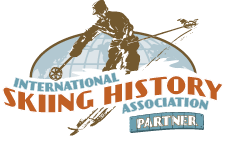
Corporate Sponsors
ISHA deeply appreciates your generous support!
World Championship
($3,000 and up)
Gorsuch
Polartec
Warren and Laurie Miller
World Cup ($1,000)
Aspen Skiing Company
BEWI Productions
Bogner
Boyne Resorts
Dale of Norway
Darn Tough Vermont
Descente North America
Dynastar | Lange | Look
Fairbank Group: Bromley, Cranmore, Jiminy Peak
Gordini USA Inc. | Kombi LTD
HEAD Wintersports
Hickory & Tweed Ski Shop
Intuition Sports, Inc.
Mammoth Mountain
Marker-Volkl USA
National Ski Areas Association (NSAA)
Outdoor Retailer
Rossignol
Ski Area Management
Ski Country Sports
Snowsports Merchandising Corporation
Sport Obermeyer
Sports Specialists, Ltd.
Sun Valley Resort
Vintage Ski World
World Cup Supply, Inc.
Gold ($700)
Race Place | BEAST Tuning Tools
The Ski Company (Rochester, NY)
Silver ($500)
Alta Ski Area
Boden Architecture PLLC
Dalbello Sports
Ecosign Mountain Resort Planners
Fera International
Holiday Valley
Hotronic USA, Inc. | Wintersteiger
MasterFit Enterprises
McWhorter Driscoll, LLC
Metropolitan New York Ski Council
Mt. Bachelor
New Jersey Ski & Snowboard Council
NILS, Inc.
Portland Woolen Mills
Russell Mace Vacation Homes
Schoeller Textile USA
Scott Sports
Seirus Innovations
SeniorsSkiing.com
Ski Utah
Tecnica Group USA
Timberline Lodge & Ski Area
Trapp Family Lodge
Western Winter Sports Reps Association
World Pro Ski Tour
The International Skiing History Association (ISHA) is grateful to the generous corporate sponsors who share our commitment to preserving skiing history and sharing it with the world. During this difficult time, your financial support is vital to our success, and we urge our members to support you in return. —ISHA Board of Directors


